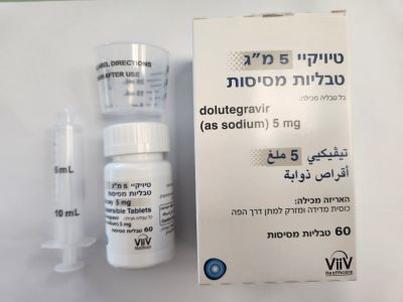Quest for the right Drug

טיויקיי 5 מ"ג טבליות מסיסות TIVICAY 5 MG DISPERSIBLE TABLETS (DOLUTEGRAVIR AS SODIUM)
תרופה במרשם
תרופה בסל
נרקוטיקה
ציטוטוקסיקה
צורת מתן:
פומי : PER OS
צורת מינון:
אין פרטים : DISPERSIBLE TABLETS
עלון לרופא
מינוניםPosology התוויות
Indications תופעות לוואי
Adverse reactions התוויות נגד
Contraindications אינטראקציות
Interactions מינון יתר
Overdose הריון/הנקה
Pregnancy & Lactation אוכלוסיות מיוחדות
Special populations תכונות פרמקולוגיות
Pharmacological properties מידע רוקחי
Pharmaceutical particulars אזהרת שימוש
Special Warning עלון לרופא
Physicians Leaflet
Special Warning : אזהרת שימוש
4.4 Special warnings and precautions for use Integrase class resistance of particular concern The decision to use dolutegravir in the presence of integrase class resistance should take into account that the activity of dolutegravir is considerably compromised for viral strains harbouring Q148+2 secondary mutations from G140A/C/S, E138A/K/T, L74I (see section 5.1). To what extent dolutegravir provides added efficacy in the presence of such integrase class resistance is uncertain (see section 5.2). Hypersensitivity reactions Hypersensitivity reactions have been reported with dolutegravir, and were characterized by rash, constitutional findings, and sometimes, organ dysfunction, including severe liver reactions. Dolutegravir and other suspect medicinal products should be discontinued immediately if signs or symptoms of hypersensitivity reactions develop (including, but not limited to, severe rash or rash accompanied by raised liver enzymes, fever, general malaise, fatigue, muscle or joint aches, blisters, oral lesions, conjunctivitis, facial oedema, eosinophilia, angioedema). Clinical status including liver aminotransferases and bilirubin should be monitored. Delay in stopping treatment with dolutegravir or other suspect active substances after the onset of hypersensitivity may result in a life-threatening allergic reaction. Immune Reactivation Syndrome In HIV-infected patients with severe immune deficiency at the time of institution of combination antiretroviral therapy (CART), an inflammatory reaction to asymptomatic or residual opportunistic pathogens may arise and cause serious clinical conditions, or aggravation of symptoms. Typically, such reactions have been observed within the first few weeks or months of initiation of CART. Relevant examples are cytomegalovirus retinitis, generalised and/or focal mycobacterial infections, and Pneumocystis jirovecii pneumonia. Any inflammatory symptoms should be evaluated and treatment instituted when necessary. Autoimmune disorders (such as Graves’ disease and autoimmune hepatitis) have also been reported to occur in the setting of immune reconstitution, however, the reported time to onset is more variable and these events can occur many months after initiation of treatment. Liver biochemistry elevations consistent with immune reconstitution syndrome were observed in some hepatitis B and/or C co-infected patients at the start of dolutegravir therapy. Monitoring of liver biochemistries is recommended in patients with hepatitis B and/or C co-infection. Particular diligence should be applied in initiating or maintaining effective hepatitis B therapy (referring to treatment guidelines) when starting dolutegravir-based therapy in hepatitis B co-infected patients (see section 4.8). Opportunistic infections Patients should be advised that dolutegravir or any other antiretroviral therapy does not cure HIV infection and that they may still develop opportunistic infections and other complications of HIV infection. Therefore, patients should remain under close clinical observation by physicians experienced in the treatment of these associated HIV diseases. Drug interactions Factors that decrease dolutegravir exposure should be avoided in the presence of integrase class resistance. This includes co-administration with medicinal products that reduce dolutegravir exposure (e.g. magnesium/ aluminium-containing antacid, iron and calcium supplements, multivitamins and inducing agents, etravirine (without boosted protease inhibitors), tipranavir/ritonavir, rifampicin, St. John’s wort and certain anti- epileptic medicinal products) (see section 4.5). Dolutegravir increased metformin concentrations. A dose adjustment of metformin should be considered when starting and stopping coadministration of dolutegravir with metformin, to maintain glycaemic control (see section 4.5). Metformin is eliminated renally and, therefore, it is of importance to monitor renal function when co-treated with dolutegravir. This combination may increase the risk for lactic acidosis in patients with moderate renal impairment (stage 3a creatinine clearance [CrCl] 45– 59 mL/min) and a cautious approach is recommended. Reduction of the metformin dose should be highly considered. Osteonecrosis Although the aetiology is considered to be multifactorial (including corticosteroid use, biphosphonates, alcohol consumption, severe immunosuppression, higher body mass index), cases of osteonecrosis have been reported in patients with advanced HIV-disease and/or long-term exposure to CART. Patients should be advised to seek medical advice if they experience joint aches and pain, joint stiffness or difficulty in movement. Weight and metabolic parameters An increase in weight and in levels of blood lipids and glucose may occur during antiretroviral therapy. Such changes may in part be linked to disease control and lifestyle. For lipids and weight, there is in some cases evidence for a treatment effect. For monitoring of blood lipids and glucose reference is made to established HIV treatment guidelines. Lipid disorders should be managed as clinically appropriate. Lamivudine and dolutegravir The two-drug regimen of dolutegravir 50 mg film-coated tablets once daily and lamivudine 300 mg once daily was explored in two large randomized and blinded studies, GEMINI 1 and GEMINI 2 (see section 5.1). This regimen is only suitable for the treatment of HIV-1 infection where there is no known or suspected resistance to the integrase inhibitor class, or to lamivudine. Excipients Tivicay contains less than 1 mmol sodium (23 mg) per tablet, that is to say is essentially ‘sodium free’.
Effects on Driving
4.7 Effects on ability to drive and use machines Patients should be informed that dizziness has been reported during treatment with dolutegravir. The clinical status of the patient and the adverse reaction profile of dolutegravir should be borne in mind when considering the patient's ability to drive or operate machinery.

פרטי מסגרת הכללה בסל
א. התרופה תינתן לטיפול בנשא HIV.ב. מתן התרופה ייעשה לפי מרשם של מנהל מרפאה לטיפול באיידס במוסד רפואי שהמנהל הכיר בו כמרכז AIDS;ג. משטר הטיפול בתרופה יהיה כפוף להנחיות המנהל כפי שיעודכנו מזמן לזמן על פי המידע העדכני בתחום הטיפול במחלה.
שימוש לפי פנקס קופ''ח כללית 1994
לא צוין
תאריך הכללה מקורי בסל
12/01/2014
הגבלות
תרופה מוגבלת לרישום ע'י רופא מומחה או הגבלה אחרת
מידע נוסף
